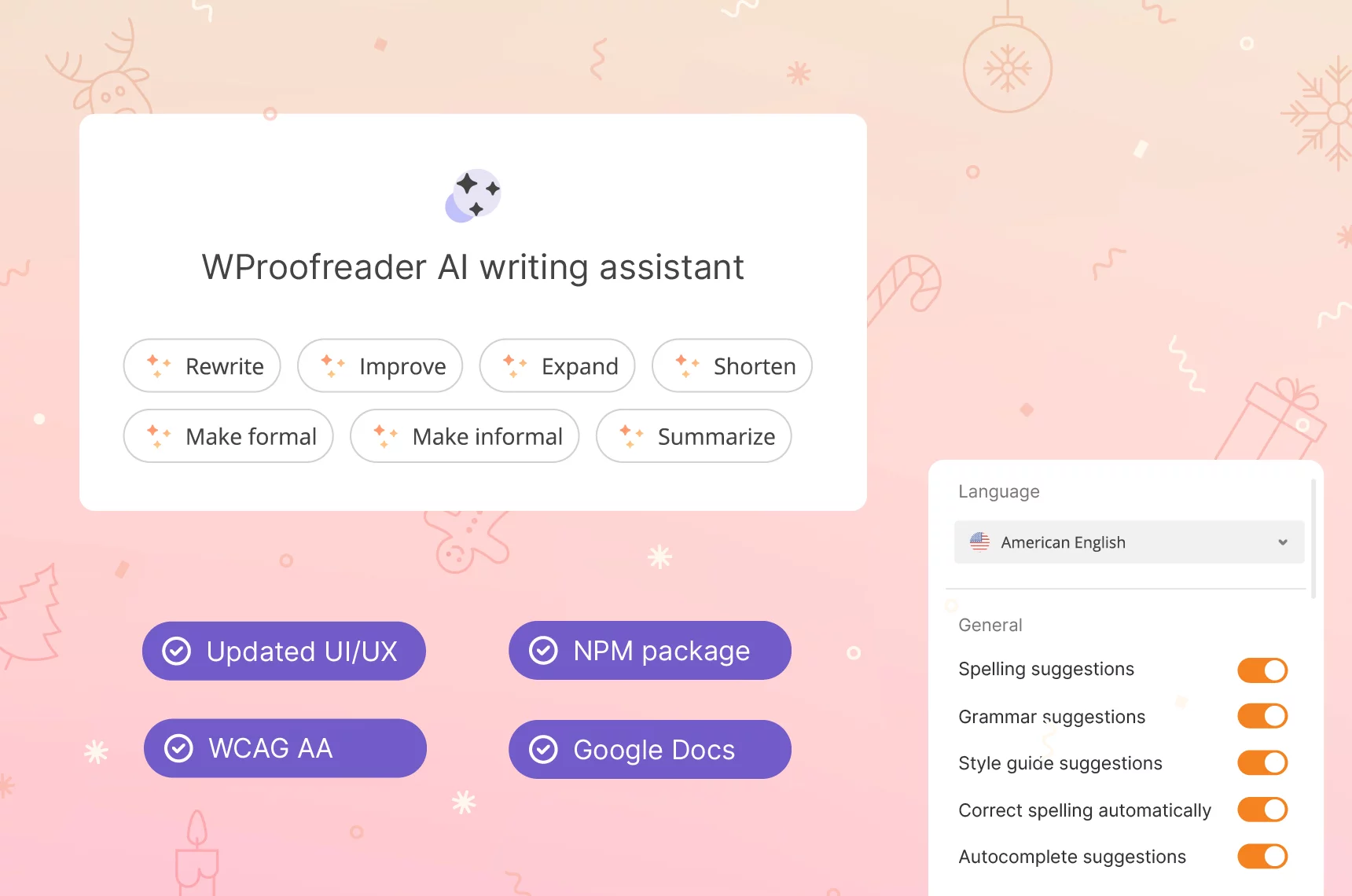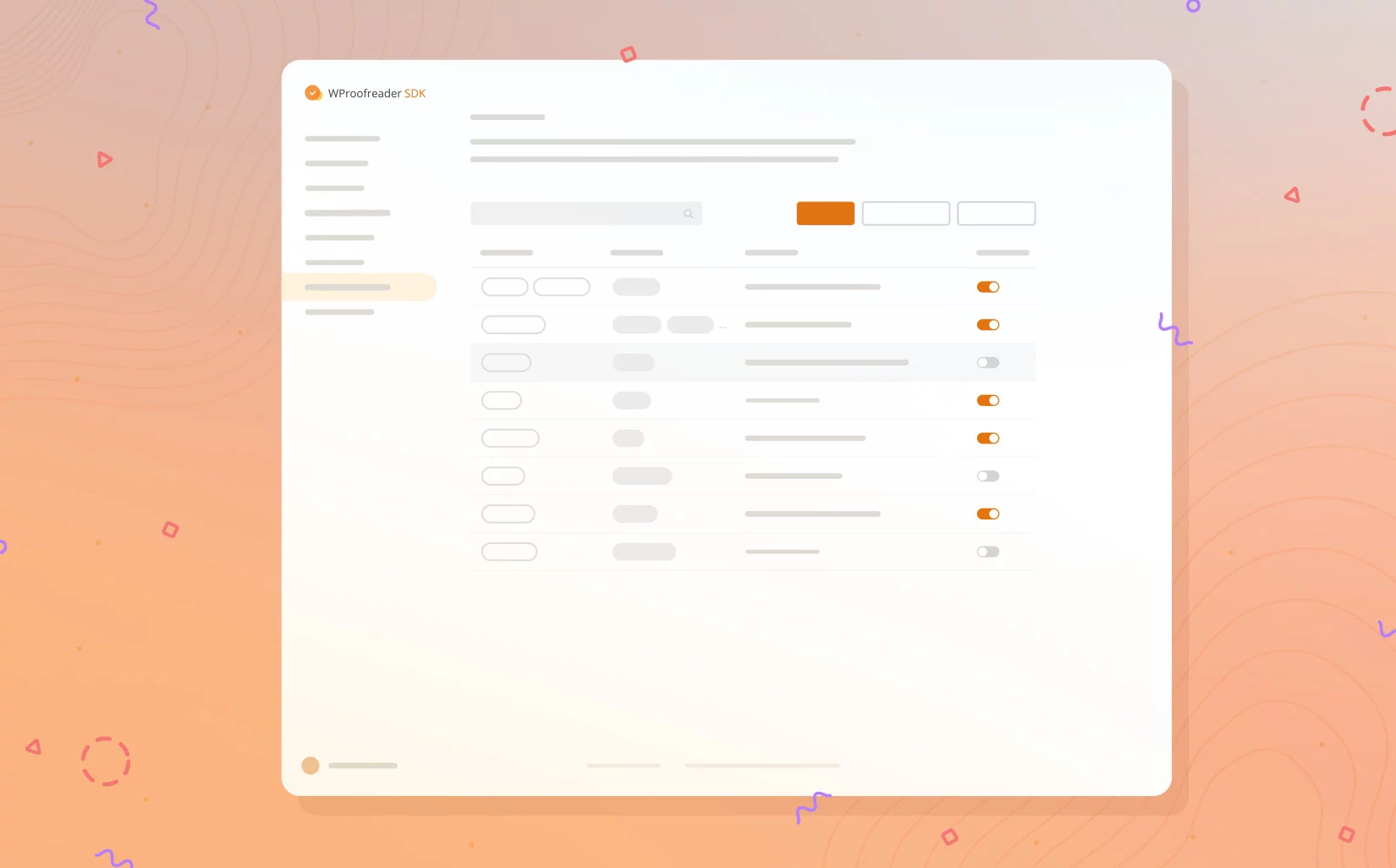So, all we might have received emails with signatures saying “John Doe he/him/his” or come across the Instagram profile with a bio Jane Doe (they/them).
Either you might have been advised to replace “businessmen” with “business people” in the product presentation or abandoning the terms “blacklist” and “whitelist” during daily meetings…
Gender-neutral language has become a new norm which all of us ought to embrace.
It’s more about tolerance and humanism, rather than a new wave of social-cultural development. That’s why inclusive language is worth respecting, talking about and following.
We at WebSpellChecker have dived deeply into the nuances of fair language, and now are sharing the insights of the research with you.
Let’s get right to the topic and master develop a skill of writing inclusively.

Geschlechtergerechte, écriture inclusive or lenguaje no sexista
Gender-neutral pronouns are a great example of fair language since they are titles, references to people, demonstrating how you refer to them.
The first coined pronouns appeared in the late 19th and early 20th centuries; for example — e, with em for the object and es for the possessive.
Then came the suffragists’ protests for using “he” when referring to women in law and singular usage of “they”. Young’s his’er, Charles Converse’s thon and, finally, today’s zim, xyrs, and perself.
However, pronouns are only one percent of gender fair language examples. The entire system is split into several levels: vocabulary, spelling and grammar patterns.
The approach varies from language to language.
While most English nouns do not have grammatical gender like teacher (he, she, they), German, French and Spanish equivalents do have.
As a result, there’s no need for specific spelling in English to compare with other languages.
In German content, you may come across fascinating spelling Lehrer*innen, Lehrer_innen or Lehrer:innen. French people like writing les président-e-s, les commerçant·e·s. Don’t get surprised when you see niñ@s, niñxs, niñ*s when reading Spanish texts.
So, by and large, the structure of the gender sensitive language is the following:
- Vocabulary level: word replacement from less inclusive to more inclusive ones, feminine job titles, avoidance of non-inclusive idioms and collocations.
- Spelling level: in some languages, they use specific spelling rules like slash, underscore, asterisks, hyphen, etc. to demonstrate the gender neutral grammar.
- Grammar level: patterns like passives, double nouns forms, replacement nouns with adjectives, plural noun forms, etc.
Let’s have a closer look at nuances of gender-neutral language in English, German, French and Spanish.
WProofreader SDK for developers
Available as a cloud or on-premise solution. Get free trial.
Explore moreEnglish gender fair language examples
Gender-neutral or inclusive language avoids bias towards a particular sex or social gender. In English, this includes use of nouns that are not gender-specific to refer to roles or professions, formation of phrases in a coequal manner, and discontinuing the blanket use of male or female terms.
Requirements and best practices for English fair language can be found in Guidelines for gender-inclusive language in English, The Chicago Manual of Style Online and UNESCWA Gender-sensitive Language Guidelines.
All they can be split into 3 levels:
- Replacing less inclusive dictionary words with more inclusive ones like man/woman→person, master→owner, etc.
- Shifting from masculine idiomatic expressions and collocations like “be his own boss” to more inclusive ones like be one’s own person.
- Paraphrasing or restructuring sentences using different grammar structures. For example, The client should receive his invoice in two weeks → The client should receive the (or an) invoice in two weeks.
Deutsche Inclusive Sprache
In 2019, Hanover became the first state capital to mandate the use of gender-neutral language in all official communication, from emails to brochures and posters. It deployed what’s known as the “gender star,” an asterisk placed within a noun to indicate it refers to men, women and nonbinary people alike. For instance, the word for all citizens became Bürger*innen.
However, the official spelling rules do not contain any statements about the characters asterisk *, colon :, underscore _ or mediodot · inside words (internal spelling).
In March 2021, the Council for German Orthography declared the inclusion of asterisk (“gender star”), underscore (“gender gap”), colon or other abbreviated forms to identify multi-gender designations in the middle of a word in the official set of rules for German orthography are not recommended at this time. The Council for German Orthography will observe the further development of writing”.
What’s recommended then?
- Double entry: full pair form (Schülerinnen und Schüler, jede und jeder)
- Substitute forms: gender-neutral overarching formulations/abstracts (Studierende, Lehrkräfte, Direktion, Gäste)
- Avoidance of the generic masculine (Sie ist Arzt → Sie ist Ärztin).
- Grammar patterns: “Alle, die(jenigen)“ + Verb”, “Passiv-, Infinitivformulierungen”, Passivsatz statt „man“, “Adjektiv anstelle Nomens”, “Plural statt Singular”, “Übereinstimmung bei gleichgeschlechtlichen Gruppen”, weibliche Bezeichnungen bei Titeln und Anreden.
French langage épicène
Inclusive language is a controversial topic in the Fifth Republic.
The Minister of Education Jean-Michel Blanquer has officially banned the use of inclusive writing via a circular, explaining that its “complexity” and its “instability” constitute “obstacles to the acquisition of language as well as reading”.
French people work on solutions to include individuals of all genders into their languages, so that the masculine isn’t seen as “default” or neutral anymore.
One of such approaches implies using a unique spelling with a mid point/hyphen, for example, es président-e-s, les commerçant·e·s. However, putting dots in the middle of words is a barrier to the transmission of our language for everyone, for example for dyslexic students.
The National Center for Scientific Research and the National Institute of the French Language recommend using feminized names of professions, titles, grades and functions, for instance, Administratrice, Fabricante, Sénatrice, etc.
Other levels of langage neutre include:
- replacing words with epicenes according to the dictionary, e.g. Les hommes → Les êtres
- Contracted shapes (mid-point/hyphen/), e.g. professeur-e-s, candidat·e·s.
- Grammar patterns (double designations, feminized job titles, article deletion, passives).
More about French rules for inclusive language can be found in Manuel ecriture inclusive, Rédaction égalitaire, 2000 noms au masculin et au feminin.
Spanish lenguaje incluyente
With Spanish, everything is pretty the same:
- replacing dictionary words with epicenes (la víctima → la persona) — this option is considered as the best one;
- the use of ending e to indicate neutral gender in words (él or ella, → elle; nosotros or nosotras → nosotres, vosotros or vosotras → vosotres). The point is that In Spanish, by default, masculine forms of parts of speech are used, which mean feminine genders too. Since the feminine in Spanish is usually denoted by the letter “a” and the masculine by the letter “o”, the neutral inclusive alternative usually uses the letter e.
- specific spelling with @, x, *, e.g. niñes, niñ@s, niñxs, niñ*s. The Real Academia de la Lengua advises this technique, however, it’s accepted that there’s a problem with the @, x, and * symbols, since they are not easy to pronounce, making them less practical.
- grammar forms (pairs of female and male, omitted determinant, collective nouns and other generic structures).
The norms of fair language in Spain are established officially by the Real Academia de la Lengua and suggested being included in dedicated guides and manuals, like GUÍA PRÁCTICA DE LENGUAJE INCLUSIVO.

Do you use an inclusive language tool?
☝️An important update.
In the latest product release, we introduced custom rules for non-inclusive and profanity writing in English. When you write a non-gender inclusive term, e.g. businessman or businesswoman, WProofreader marks it and gently suggests unbiased alternatives like business person.
Another case is swear words. Profanity is an absolute no-no-no (ok, sometimes there may be solid reasons). So, we’ve also created custom rules to detect profanity in writing.
In the near future, you can forget about the anxiety of missing some rude words in the text. For WProofreader extension users, we are going to release an AI writing assistant feature 🪄 Our AI-based rewrite tool can check any text in English, German, Spanish, Portuguese, French, Dutch and Swedish for profanity and non-inclusive languages. In addition, pre-installed prompts allow you to shorten or widen a selected section of text, change its level of formality, or even rewrite it completely.
For the purpose of this article, we checked how Grammarly, ProWritingAid, Outwrite, Sapling AI, LanguageTool and others text checkers cope with non-inclusive cases.
For the deep part of the research, we’ve collected data samples for different levels of fair language in English, German, French and Spanish. The word and sentence samples were taken from the above-mentioned sources.
Then we compared solutions and here’s what we got.
English
Solutions (ProWritingAid, Grammarly, Outwrite, Sapling AI) generally do not automatically detect non-inclusive cases in free versions. Basically, cases with the root man are being detected.
ProWritingAid and Grammarly Premium offer a separate “inclusive language” feature, which is implemented only at the dictionary level.
Here’s an example.
English Demo text with 3 non-fair language cases:
Chairmen are cordially invited to attend with their wives. Professor Smith and Madeline will attend the luncheon.
- Chairmen — some terms, such as chairman, that contain the component man are now seen by some as gender-specific.
- Attend with their wives — LGBTQ+ language, better to use partners instead of wives.
- Professor Smith and Madeline — unfair attitude to women, when referring to them only by using their name without a title.
ProWritingAid detects only the first case and suggests replacement options such as chairpersons, conveners, etc.
Grammarly shows the same behavior: the checker warns the user about writing unfairly and suggests considering a more neutral noun form.
Outwrite and Sapling AI don’t support inclusive language functionality.

German
We’ve tested LanguageTool German and Duden Mentor on a set of vocabulary, spelling and grammar cases.
LanguageTool free sometimes detects and offers word replacements from the dictionary (Wahlmänner → Wahlleute). As for spelling forms — all non-standard variations (asteriks, slash, hyphen, brackets, BinnenI) are recognized and not detected as errors, while dynamic underscore, x and xs are detected as errors.
Duden Mentor does not support less inclusive writing: spelling cases are underlined, no suggestions for vocabulary cases, grammar patterns are not recognized.
German Demo text with 1 non-fair language case:
Die Professoren fassten in der Fakultätssitzung einen einstimmigen Beschluss.
Die Professoren — plural masculine form, to meet inclusivity standards, it’s recommended to use a double form Die Professorinnen und Professoren.
Neither LanguageTool German nor Duden Mentor sees the case, and, hence, doesn’t offer any improvements.

French
We’ve checked the list of less inclusive words in LanguageTool, MerciApp, and Outwrite. There are no underscores or suggestions for inclusiveness provided by the solutions. As for the list of female occupations, it feels like all checkers give around 20% false positives, which means that French dictionaries they use are not complete. By checking phrases: no one detects stylistic moments of inclusiveness.
Contracted spelling forms: LanguageTool French recognizes mid-point spelling and doesn’t detect it as an error, but hyphen is considered to be an error. Other checkers don’t accept this type of spelling.
French demo text with 1 global non-fair language case:
Mme X, recteur de l’Université de Lausanne a parfaitement repli sa fonction.
This sentence contains singular masculine form recteur, which does not correspond to the subject Mme X. All should be replaced with a feminine job title — rectrice.

Spanish
According to our research, LanguageTool and Outwrite (free both) don’t support gender-neutral spelling. Contracted forms like -es, -@s, -xs, -*s are detected as errors.
Spanish demo text with 1 global non-fair language case:
María Sánchez; director, jefe, abogado, médico, el oficial de programa, el oficial de protección, el ingeniero.
This sentence contains singular masculine form, which does not correspond to the subject María Sánchez. All should be replaced with feminine job names and titles.

A wrap-up
Well, inclusive language is a well-known standard, not officially developed and established in all languages (compared to English) though. By default, it consists of several levels: spelling, vocabulary, and grammar patterns.
Inclusive language ensures fair business communication in B2B and B2C sectors and reflects the modern cultural tendencies. Complying with all the standards of inclusivity may be a challenge, so chances are that individuals and businesses may need a digital assistant to help with this task.
We’ve run deep research on how text checkers serve the purpose of inclusive language tools. The majority of solutions cover only the first two levels of inclusive language: spelling and vocabulary; grammar cases aren’t implemented at all. The implementation of a fair language feature is tedious: huge datasets are required, as well as checking algorithms should be elaborated to provide relevant suggestions.











